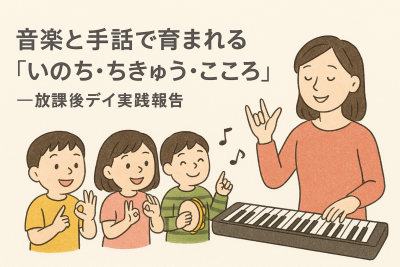
昨日は放課後等デイサービスにて、
あそびうたリトミックの専門プログラムを実施しました。
今回のセッションは、
① 手話 × 発声 → ② 一人ずつのキーボード演奏 → ③ 手話歌
という流れで構成し、音楽・身体・言語の働きが自然に統合されるよう設計しています。
① 手話 × 発声
手話の動きに合わせて声を出す活動では、
身体図式の確立・呼吸調整・音声の方向づけが促されます。
視覚的な情報と音声が一致しやすいため、
発達特性のある子どもたちも安心して取り組める導入となりました。
② 一人ずつのキーボード演奏
鍵盤に向かう時間は、
「どの音にするか」「いつ弾くか」という
自己決定と予測可能性の育ちが最もあらわれる瞬間です。
音を選ぶ → 試す → 発表する
というプロセスの中で、
注意の切り替え・聴覚認知・微細運動が段階的に引き出されました。
③ 手話歌
最後は、歌詞の意味を身体で表しながら歌う手話歌。
ことば・動き・感情が一致しやすく、
情緒の安定・共感性の育ち・自己表現の拡張につながります。
子どもたちの表情がやわらぎ、
「気持ちをこめて歌う」経験が自然に生まれていました。
🌈 音楽 × 手話 × 身体表現が生む、安心と主体性
音楽は、
視覚・聴覚・触覚が同時に働くことで、
その子が“今できる力”を安全に引き出す場をつくります。
昨日のレッスンでも、
それぞれが自分のペースで取り組みながら、
音と動きの中で表情が変化していく姿が印象的でした。
今後も、
あそびうたリトミック × 感覚統合 × 手話表現
という協会独自のアプローチを通して、
子どもたちの創造性と自己表現力を育んでいきます。
Yesterday, we conducted our Asobiuta Rhythmic Program at an afterschool day service.
This session was designed to integrate music, sign language, body movement, and vocal expression, allowing children to engage through multiple sensory channels in a safe and supportive environment.
1. Sign Language × Vocal Expression
We began with sign-supported vocal activities.
The combination of gesture and sound strengthens:
For children with developmental differences, the clear visual cues provided by sign language help create predictability and emotional safety during the warm-up phase.
2. Individual Keyboard Performance
Each child then approached the keyboard one by one.
This process naturally supports:
Trying a sound → adjusting it → sharing it with others
creates a structured pathway that fosters confidence and focused attention.
3. Sign-Language Song
In the final activity, children sang while expressing the lyrics through sign language.
This multimodal approach helps:
We observed many moments where feelings, gestures, and music aligned beautifully.
Integrated Approach: Music × Sign Language × Sensory-Motor Engagement
Music activates emotional, auditory, and motor pathways simultaneously.
Because of this, it becomes a uniquely effective tool for drawing out the child’s current strengths in a safe, joyful manner.
In this session as well, each child engaged at their own pace,
and the combination of rhythm and gesture supported natural expression and emotional stability.
Going forward, we will continue to advance our unique approach combining:
Asobiuta Rhythmic Education × Sensory Integration × Sign-Language Expression,
to nurture children’s creativity, communication, and sense of self.



